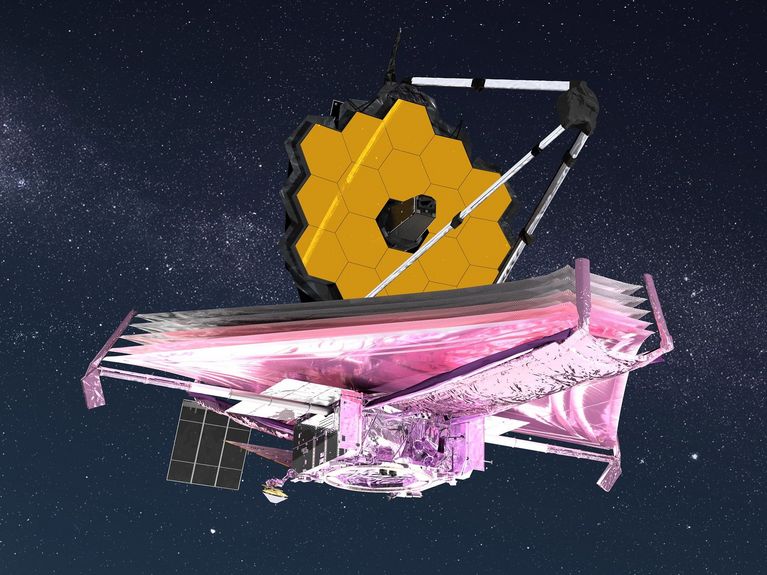James Webb Space Telescope
The eye of mankind is ice cold

Artist's rendering of the James Webb telescope. Image: NASA GSFC/CIL/Adriana Manrique Gutierrez, CC BY 2.0
The James Webb Space Telescope is delivering its first images from its location 1.5 million kilometers from Earth. It is expected to provide completely new insights into the depths of space. For this to work, it must be cooled to temperatures close to absolute zero.
On Christmas Day 2021, the James Webb Space Telescope lifted off from French Guyana on a European Ariane 5 rocket. Thousands and thousands of people watched the live broadcast of the rocket launch with great excitement - and no wonder. Decades of work by thousands of researchers and engineers and investments of around ten billion US dollars depended on a successful launch.
The first big sigh of relief came when the James Webb Space Telescope successfully detached from the rocket's upper stage after 27 minutes. It was not until the following days that it became known that the Ariane 5 had brought the telescope onto its trajectory with unexpected precision, so that it had to use significantly less fuel than planned for course corrections. A stroke of luck, because the unexpected fuel supply will now enable the James Webb Space Telescope to conduct significantly more than 10 years of research in space.
Special technology for special instruments
Named after a former head of NASA, the high-tech instrument is the successor to the Hubble telescope, which has sent some 120 gigabytes of data to Earth since the 1990s and provided the basis for some 18,000 scientific publications. The "Webb" is the most powerful telescope ever built. Its extraordinary design has one goal: to collect as much infrared radiation as possible from the depths of the universe. The astronomers mainly want to collect the infrared radiation coming from the first celestial bodies, thus providing a glimpse into the astronomical past. A large main mirror six and a half meters in diameter, consisting of 18 hexagonal segments, collects the radiation. A massive solar sail the size of a tennis court, consisting of several layers of ultra-thin metal foil, protects the telescope from the heat of the sun.
One of the first MIRI test images shows part of the Large Magellanic Cloud. A small satellite galaxy of the Milky Way. Next to it, for comparison, is an image of the same spot in the sky from a predecessor infrared space telescope called the Spitzer Image: NASA. CC BY 2.0
At first glance, space seems cold above all else. But an instrument like the James Webb Space Telescope has to protect itself from heat, of all things. This is because the infrared radiation it is supposed to capture is also known as "thermal radiation." All objects in the universe emit some amount of this radiation themselves, depending on their temperature. Trying to capture weak infrared radiation from space with a telescope that is too warm would be like hopelessly trying to observe the night sky in a brightly lit soccer stadium.
The Mid Infrared Instrument (MIRI) is cooled the most. While the other instruments are kept at around -235 °C thanks to solar sails and passive heat dissipation, MIRI requires an unimaginably frigid -266 °C. That's only about seven degrees above absolute zero, the lowest possible temperature in the universe. This is achieved with a cooling device based on the principle of a refrigerator, but one that relies on liquid helium as a coolant.
"The reason is that MIRI observes at longer wavelengths than the other instruments. The longer the wavelength, the more cooling is required to still 'see' the cold astronomical objects," explains Heinz-Theo Hammes of the German Space Agency at the German Aerospace Center (DLR).
German participation in cryogenics
The telescope is a major international project led by NASA. The Max Planck Institute for Astronomy (MPIA) in Heidelberg and the I. Institute of Physics at the University of Cologne are also involved. "The MPIA developed the cryo-mechanisms for MIRI and built and tested them together with Hensoldt Optronics. These cryo-mechanisms are used to move MIRI's filter and grating wheels," Hammes reports. "The University of Cologne was involved in the filter development. It designed and built two filters and their mounts."
"Both institutes were also heavily involved in the testing activities of the MIRI instrument; both at the system level and during the integration of the instrument and later the satellite," says Heinz-Theo Hammes. A particular challenge was the fundamentally different conditions under which the instrument had to function, which Hammes lists: "At laboratory conditions of around 22 °C with less than 40% humidity, during the telescope's extensive preliminary tests at 20 °C and 20 to 50% humidity, during tests at the tropical launch site with 25 to 35 °C and particularly high 40 to 85% humidity - and finally in space at less than -266 °C in a vacuum."
The work paid off: in early May, NASA released a first image from the MIRI instrument. It shows a razor-sharp view of part of the Large Magellanic Cloud, a neighboring galaxy to our Milky Way, including large clouds of interstellar gas that fill the space between the stars. Not only in Cologne and Heidelberg, but all over the world, astrophysicists are looking forward to what MIRI and the James Webb Space Telescope will reveal to them in the future.
Links
- https://webb.nasa.gov/content/meetTheTeam/team.html
- https://www.planetary.org/articles/cost-of-the-jwst
- https://blogs.nasa.gov/webb/2021/12/29/nasa-says-webbs-excess-fuel-likely-to-extend-its-lifetime-expectations/
- https://jwst.nasa.gov/content/about/innovations/cryocooler.html
- https://blogs.nasa.gov/webb/2022/05/09/miris-sharper-view-hints-at-new-possibilities-for-science/
Readers comments